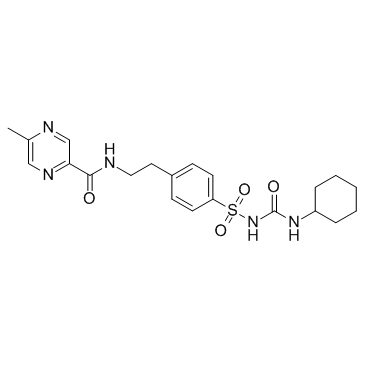Glyburide and glipizide, second-generation oral sulfonylurea hypoglycemic agents.
Renée E Haskew-Layton, Jimmy B Payappilly, Hongbin Xu, Steffany A L Bennett, Rajiv R Ratan
文献索引:Clin. Pharm. 3(5) , 473-85, (1984)
全文:HTML全文
摘要
The chemistry, pharmacology, pharmacokinetics, clinical efficacy, adverse effects, and dosage of glyburide and glipizide, two second-generation oral sulfonylurea hypoglycemic agents, are reviewed. Glyburide and glipizide are well absorbed after oral administration. The absorption of glipizide is delayed by food; in contrast, glyburide absorption does not seem to be affected by administration with meals. Both drugs are extensively metabolized by the liver. A two-compartment open model adequately describes the pharmacokinetics of these drugs. The apparent elimination half-life of glyburide in oral dosage forms available in the United States ranges from 7 to 10 hours. Glipizide has a terminal elimination half-life of 2-7 hours. The effects of renal and hepatic disease on the pharmacokinetics of glyburide and glipizide have not been well studied. Based on controlled, comparative studies in patients with new-onset, diet-failed, Type II diabetes, glyburide appears to be at least as effective as chlorpropamide and tolazamide in controlling blood glucose. Glipizide has shown efficacy comparable to or greater than that of chlorpropamide and tolbutamide. Glyburide and glipizide appear to be comparable in terms of their ability to control fasting blood glucose in Type II diabetics. The recommended initial dosage of glyburide in newly diagnosed Type II diabetics is 2.5-5 mg once daily. For glipizide, the initial dosage should be 5 mg once daily. Elderly or debilitated patients and those with renal or hepatic impairment should be started on lower dosages initially. Glyburide and glipizide have adverse effects that are similar to those observed with the first-generation oral hypoglycemic agents. Glyburide and glipizide do not appear to offer major therapeutic advantages over first-generation oral sulfonylurea hypoglycemic agents. However, they may represent therapeutic alternatives for some patients who do not respond satisfactorily to other sulfonylureas.
相关化合物
| 结构式 | 名称/CAS号 | 分子式 | 全部文献 |
|---|---|---|---|
 |
格列吡嗪
CAS:29094-61-9 |
C21H27N5O4S |
|
Identification of CYP3A7 for glyburide metabolism in human f...
2014-12-15 [Biochem. Pharmacol. 92(4) , 690-700, (2014)] |
|
Maternal-fetal disposition of glyburide in pregnant mice is ...
2014-08-01 [J. Pharmacol. Exp. Ther. 350(2) , 425-34, (2014)] |
|
Quantitative determination of metformin, glyburide and its m...
2015-04-01 [Biomed. Chromatogr. 29(4) , 560-9, (2015)] |
|
Glipizide, an antidiabetic drug, suppresses tumor growth and...
2014-10-30 [Oncotarget 5(20) , 9966-79, (2014)] |
|
Glimepiride reduces CD14 expression and cytokine secretion f...
2014-01-01 [J. Neuroinflammation 11 , 115, (2014)] |